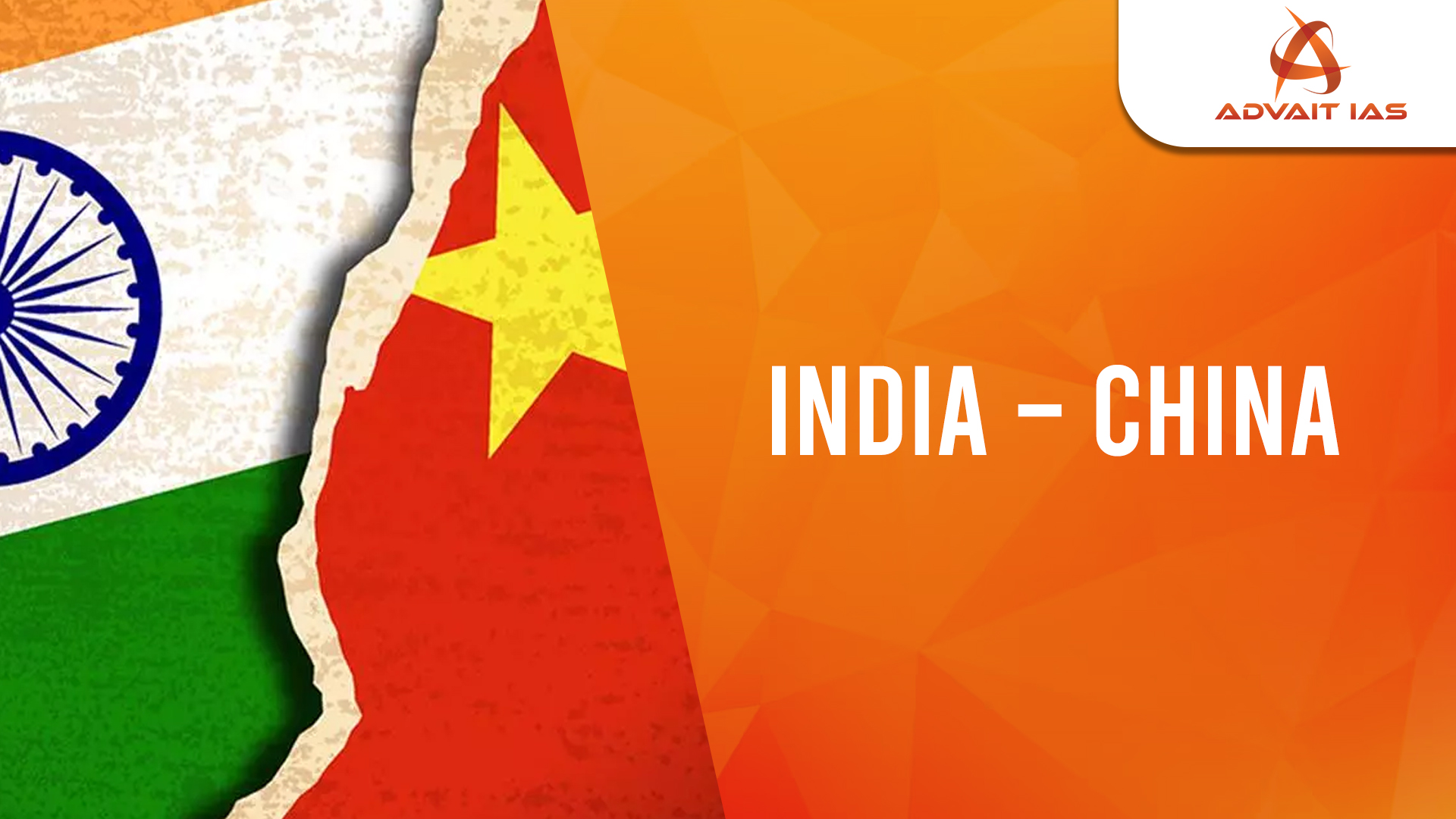India and China have set their bilateral ties in the “direction of some improvement,” External Affairs Minister S. Jaishankar told Parliament on Tuesday. He credited “continuous diplomatic engagement” and a step-by-step approach with Beijing for achieving disengagement in the border areas.
India-China Relations: Background
The evolution of India-China relations is shaped by historical ties, geopolitical dynamics, and economic interests.
- Historical Background
-
- Ancient Ties: Cultural and economic exchanges date back to the Silk Road era and the spread of Buddhism from India to China.
- Colonial Era: Interaction diminished as both nations came under colonial rule.
- Post-Independence (1947-1962)
-
- Initial Cooperation: India’s independence (1947) and China’s establishment as the People’s Republic (1949) led to the Panchsheel Agreement (1954) based on five principles of peaceful coexistence.
- 1962 War: Tensions over Aksai Chin and Arunachal Pradesh culminated in the Sino-Indian War, leaving a lasting impact on bilateral ties.
- Cold War Era (1962-1988)
-
- Diplomatic Freeze: Relations remained strained, with both aligning with opposing Cold War blocs.
- Limited Engagement: Some trade continued despite sporadic skirmishes along the Line of Actual Control (LAC).
- Normalization (1988-2000)
-
- Rajiv Gandhi’s Visit (1988): Marked the start of normalization, with Joint Working Groups formed to discuss border issues.
- Trade & CBMs: The 1990s saw growing trade and confidence-building measures, though border issues persisted.
- Strategic & Economic Engagement (2000-2010)
-
- Economic Ties: By 2008, China became India’s largest trading partner, with cooperation in BRICS and SCO.
- Strategic Competition: Tensions rose in the Indian Ocean Region and South Asia, fueled by China’s ties with Pakistan and influence in Nepal, Sri Lanka, and Bangladesh.
- Tensions & Confrontations (2010-Present)
-
- Border Incidents: Notable standoffs include Depsang (2013), Chumar (2014), Doklam (2017), and the Galwan Valley clash (2020), marking the worst escalation since 1962.
- Current Dynamics: Relations remain tense, with ongoing talks for disengagement at the LAC, while India seeks to reduce economic dependence on China.
Areas of Cooperation Between India and China
Despite differences and border tensions, India and China have established multiple areas of cooperation:
- Trade and Economic Cooperation
-
- Bilateral Trade: In 2023, trade reached $135.98 billion, with China being a top trading partner. However, India faces a significant trade deficit of $71.56 billion.
- Investment: Chinese firms have invested in Indian sectors like tech, infrastructure, and manufacturing, with companies like Xiaomi, Realme,Vivo, and Alibaba having a strong presence.
- Multilateral Cooperation
-
- BRICS: Both countries collaborate on economic development, global financial reform, and climate change.
- SCO: India and China work together on regional security, counter-terrorism, and economic initiatives.
- Climate Change and Environment
-
- Climate Agreements: Both nations are signatories to the Paris Agreement and cooperate under UNFCCC to reduce emissions and boost renewable energy use.
- Clean Energy: India and China exchange expertise in solar and wind energy to combat climate change.
- Cultural and People-to-People Exchanges
-
- Education: About 23,000 Indian students were studying in China in 2023, primarily in medicine.
- Tourism: Pre-pandemic, tourism and cultural exchanges (film, music, arts) were growing.
- Healthcare and Pharmaceuticals
-
- Pharmaceuticals: China supplies active pharmaceutical ingredients (APIs) crucial for India’s pharma industry.
- Pandemic Response: Both countries shared medical practices and supplies during COVID-19.
- Science and Technology
-
- Joint Research: Both nations have collaborated in space, biotechnology, and IT through joint research projects.
- Digital Economy: Chinese tech firms contribute to India’s digital sector through investments and tech partnerships.
- Regional and Global Security
-
- Counter-Terrorism: India and China share intelligence and conduct joint anti-terrorism military exercises under
- Afghanistan: Both nations have coordinated to ensure regional stability following the U.S. withdrawal.
Key Challenges in India-China Relations
- Border Disputes
-
- Western Sector (Ladakh): India claims Aksai Chin as part of Jammu & Kashmir (Ladakh) per the Johnson Line, while China favors the McDonald Line, asserting control over Aksai Chin.
- Middle Sector (Himachal Pradesh & Uttarakhand): Minor disputes exist, with broad agreement on the Line of Actual Control (LAC).
- Eastern Sector (Arunachal Pradesh & Sikkim): China disputes the McMahon Line, claiming Tibetan representatives lacked authority in the 1914 Shimla Convention.
- Border Incursions
-
- Undefined and disputed LAC leads to frequent confrontations, including incidents at Demchok (2014), Depsang (2015), Doklam (2017), and Galwan Valley (2020).
- Water Sharing
-
- China’s upstream position allows leverage over rivers like the Brahmaputra, raising concerns over dam-building and water flow control.
- Tibet Issue
-
- India hosts the Tibetan government-in-exile and the Dalai Lama, leading to Chinese accusations of support for separatism, while India maintains the “One China” policy.
- Trade Imbalance
-
- India faced a $87 billion trade deficit with China in 2022, with challenges like regulatory barriers, intellectual property rights issues, and market opacity.
- Concerns over Belt and Road Initiative (BRI)
-
- India opposes the China-Pakistan Economic Corridor (CPEC) in Pakistan-occupied Kashmir (PoK) and advocates for adherence to international norms, avoiding debt traps, and environmental risks.
Geopolitical Factors Behind China’s Assertion
- Salami Slicing Strategy
-
- Incremental territorial expansion through small steps. Evident in the South China Sea and the Himalayas, with the Doklam standoff as a key example.
- Debt Trap Diplomacy
-
- Extending loans for infrastructure projects to create economic dependence. If repayment fails, China gains control over strategic assets, expanding its global influence.
- Five Fingers of Tibet Strategy
-
- China’s strategic aspirations to control:
- Ladakh: Access to Pakistan.
- Nepal: Strategic entry to India’s heartland.
- Sikkim: Potential to sever India’s “Chicken Neck” (Siliguri Corridor).
- Bhutan: Greater proximity to Bangladesh.
- Arunachal Pradesh: Extended military reach in India’s northeast.
- String of Pearls Strategy
-
- Establishing a network of Chinese-controlled ports across the Indian Ocean, including Gwadar (Pakistan), Male (Maldives), Hambantota (Sri Lanka), Chittagong (Bangladesh) and Djibouti (Horn of Africa), aimed at strategically encircling India.
India’s Response to China’s Aggressive Measures
- Global Strategic Alliances
-
- QUAD: Active engagement with Australia, the US, and Japan to uphold democratic values, maritime trade, and security.
- I2U2: Newer alliance with Israel, the USA, and UAE to boost India’s regional geopolitical standing.
- India-Middle East-Europe Economic Corridor (IMEC)
-
- An alternative trade and connectivity initiative, countering China’s BRI and strengthening India’s presence in the Arabian Sea and Middle East.
- International North-South Transport Corridor (INSTC)
-
- A 7,200-km multi-modal network with India, Iran, and Russia, connecting the Indian Ocean, Persian Gulf, and Caspian Sea. Strategic use of Chahbahar Port to monitor China’s regional activities.
- Indian Ocean Rim Association (IORA)
-
- Promotes economic cooperation and regional integration among Indian Ocean-bordering nations.
- Necklace of Diamonds Strategy
-
- India’s counter to China’s “String of Pearls,” enhancing naval presence, expanding military bases, and strengthening diplomatic ties in the Indo-Pacific and Indian Ocean regions.






